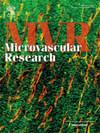Nailfold capillary morphology changes in patients with retinal vein occlusion
IF 2.7
4区 医学
Q2 PERIPHERAL VASCULAR DISEASE
引用次数: 0
Abstract
Aim
To investigate the changes in the morphology of nailfold capillaries in patients with retinal vein occlusion (RVO) and their relationship with retinal vessel density (RVD).
Methods
This cross-sectional study, included 30 patients with RVO and 30 normal controls. Nailfold capillaroscopy was used to evaluate the morphology of the nailfold capillaries, and optical coherence tomography angiography was used to evaluate RVD.
Results
Abnormal morphological features of nailfold capillaries, including lower capillary density (p < 0.001), more tortuous capillaries (p = 0.003), more capillary dilation >25 μm (p = 0.001), and more avascular areas >200/μm (p < 0.001), were more common in patients with RVO than in normal controls. Compared to the normal eye, the affected eyes of patients with RVO showed lower RVD in the superficial vascular plexus (SCP), intermediate capillary plexus (ICP) and deep capillary plexus (DCP). There following correlations between abnormal nailfold capillaries and RVD in affected eyes of RVO patients were observed: the number of nailfold capillary hemorrhages was negatively associated with RVD in the SCP (ρ = −0.376, p = 0.046) and ICP (ρ = −0.506, p = 0.004); the number of dilated capillaries >25 μm was negatively associated with RVD in the ICP (ρ = −0.389, p = 0.033); and the number of avascular zones >200/μm was negatively associated with RVD in the DCP (ρ = −0.374, p = 0.041).
Conclusions
Patients with RVO have abnormal morphology of the nailfold capillaries. In addition, nailfold capillary changes are correlated with RVD, suggesting that systemic microcirculatory abnormalities may be associated with RVO.
视网膜静脉闭塞患者甲襞毛细血管形态的改变
目的探讨视网膜静脉闭塞(RVO)患者甲襞毛细血管形态的变化及其与视网膜血管密度(RVD)的关系。方法采用横断面研究,选取30例RVO患者和30例正常对照。甲襞毛细血管镜检查评估甲襞毛细血管形态,光学相干断层扫描血管造影评估RVD。结果甲襞毛细血管形态异常,包括毛细血管密度降低(p <;0.001),更弯曲的毛细血管(p = 0.003),更多的毛细血管扩张>;25 μm (p = 0.001),更多的无血管区域>;200/μm (p <;0.001),在RVO患者中比在正常对照中更常见。与正常眼相比,RVO患者患眼的浅血管丛(SCP)、中毛细血管丛(ICP)和深毛细血管丛(DCP)的RVD均较低。RVO患者患眼甲襞毛细血管异常与RVD的相关性为:SCP (ρ = - 0.376, p = 0.046)和ICP (ρ = - 0.506, p = 0.004)中甲襞毛细血管出血数与RVD呈负相关;25 μm的扩张毛细血管数量与ICP内RVD呈负相关(ρ = - 0.389, p = 0.033);无血管带数>;200/μm与DCP的RVD呈负相关(ρ = - 0.374, p = 0.041)。结论RVO患者甲襞毛细血管形态异常。此外,甲襞毛细血管变化与RVD相关,提示全身微循环异常可能与RVO有关。
本文章由计算机程序翻译,如有差异,请以英文原文为准。
求助全文
约1分钟内获得全文
求助全文
来源期刊

Microvascular research
医学-外周血管病
CiteScore
6.00
自引率
3.20%
发文量
158
审稿时长
43 days
期刊介绍:
Microvascular Research is dedicated to the dissemination of fundamental information related to the microvascular field. Full-length articles presenting the results of original research and brief communications are featured.
Research Areas include:
• Angiogenesis
• Biochemistry
• Bioengineering
• Biomathematics
• Biophysics
• Cancer
• Circulatory homeostasis
• Comparative physiology
• Drug delivery
• Neuropharmacology
• Microvascular pathology
• Rheology
• Tissue Engineering.
 求助内容:
求助内容: 应助结果提醒方式:
应助结果提醒方式:


